BenQ E2200HD and E2400HD - 1080P FullHD LCDs
by Jarred Walton on November 4, 2008 5:00 AM EST- Posted in
- Displays
Color Accuracy
Imaging professionals definitely like to have accurate colors, and the best way of assuring that your display shows the proper colors is to use a colorimeter and calibration software. However, not everyone has access to such tools and many users are unwilling to spend over $200, so we test before and after calibration. (Put more accurately, we calibrate the monitors and then tweak the created profile back to an uncalibrated level so that we can evaluate the performance of the display in its default state.) For calibration, we target a white level of 200 nits -- anything more than that is too bright in our opinion. We also do a second calibration targeting a white level of 100 nits, which would be useful when working on material that will end up in print form. Before we get to the results, here are the display settings we used on the test LCDs. We let the LCDs stabilize for at least one hour before performing measurements. We will compare results with the Dell 2408WFP, which so far has achieved the best overall color accuracy of any LCD we have tested.
| LCD Brightness and Contrast Settings | ||
| Standard Calibrated (~200 nits) | Calibrated for Print (~100 nits) | |
| BenQ E2200HD | 65 Brightness, 50 Contrast "Normal" (95-95-95 RGB) |
20 Brightness, 50 Contrast "Normal" (95-95-95 RGB) |
| BenQ E2400HD | 73 Brightness, 50 Contrast "Normal" (94-94-91 RGB) |
30 Brightness, 50 Contrast "Normal" (94-94-91 RGB) |
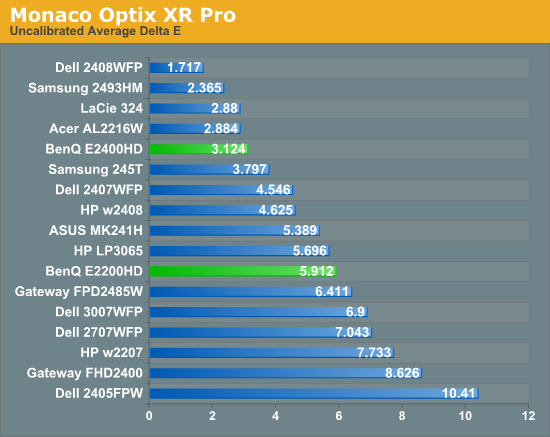
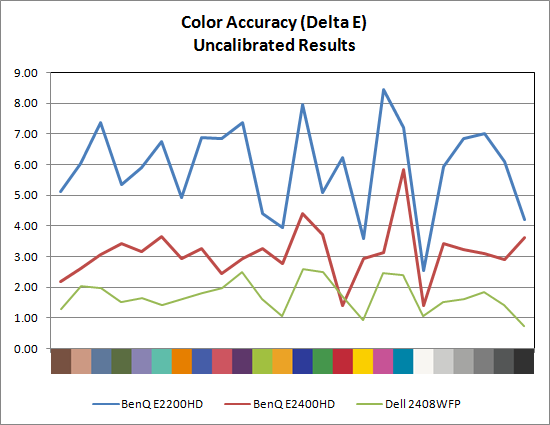
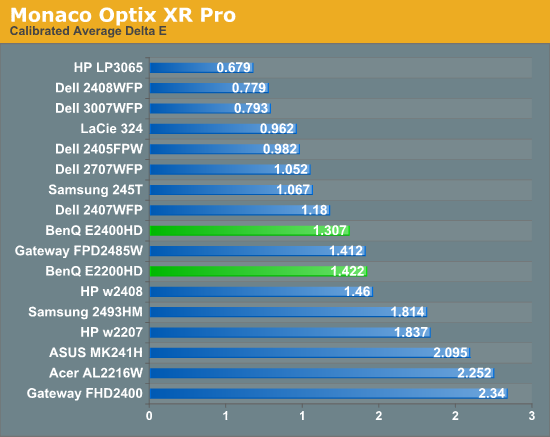

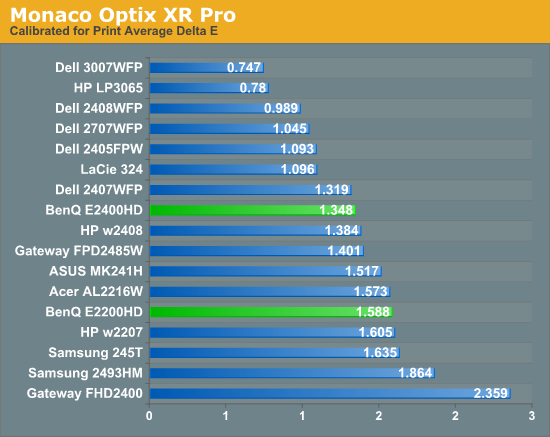
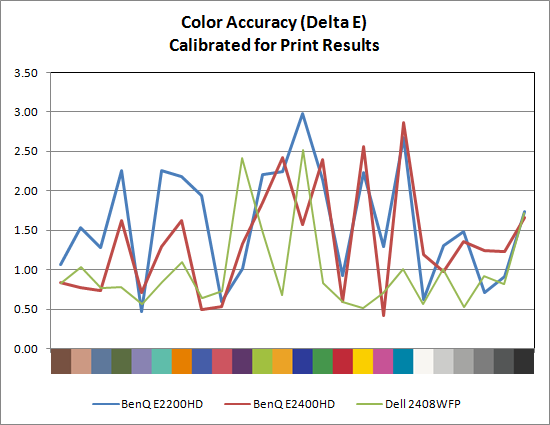
Starting with the uncalibrated results, it's pretty easy to see why we feel calibration tools are necessary for imaging professionals. This is not to say that you can't be happy with inaccurate colors -- your eyes will compensate, and some people prefer warmer (redder) or cooler (bluer) tones. However, if you're doing work with images or video, it is important that what you see on your display matches as much as possible what others will see on their displays. Of the LCDs we've tested, four are able to achieve an average Delta E of less than 3.0 without calibration (according to Monaco Optix XR Pro). The BenQ E2400HD falls just short, but is close enough that very few people would mind. The Dell 2408WFP is still in a class of its own, with an uncalibrated Delta E of 1.72 -- a score that's better than several of the LCDs after calibration!
With calibration, all the scores improve substantially, but anyone serious about color accuracy is probably going to want an average Delta E of around 1.0 or less post-calibration. So far, only S-PVA and S-IPS panels achieve that goal, with the E2200HD and E2400HD falling just short. Switching to appropriate "printing" settings causes a few minor changes, but the S-IPS panels still maintain a clear lead over any other LCD.










33 Comments
View All Comments
10e - Wednesday, November 5, 2008 - link
If the last MVA panel from BenQ/AUO is any indicator, input lag should be low. I had the FP241VW with December 2007 firmware and it was 7.9ms behind a CRT, with only 5% of the time it being 2 frames behind. The other times it was only 1 frame behind, or none at all.It's good to see that our crying over on another forum has kept BenQ and AUO from abandoning the non-TN market altogether
The only tiny issue with it was dark greys shifted more than (say) my Dell 2709W (S-PVA). Good luck with the review.
Jorgerr - Tuesday, November 4, 2008 - link
Did you check the Samsung T220P? looks that have the same specs as the Benq. Seems to be a very interesting competitor as well.I would appreciate to read your comments about it.
JarredWalton - Tuesday, November 4, 2008 - link
Looks like that was an Asian release only? I'm not sure... spec-wise, it's actually a 1920x1200 LCD, and I haven't seen any of those in 22" trim over here in the US. Weird. Honestly, I wouldn't be surprised if Samsung makes the panel in the BenQ LCDs; then again, it's either Samsung, AU Optronics, or Chi-Mei so I have a 33% chance of guessing right. ;-)Jorgerr - Tuesday, November 4, 2008 - link
Thanks :-) In Israel the Samsung T220P is available, and we belongs to Asia.Good luck with the new president! No matter who will be I wish you the best.
NARC4457 - Tuesday, November 4, 2008 - link
[quote]We are only aware of one other 22" LCD manufacturer that offers native 1080P support (ViewSonic), and we feel this is an untapped market.[/quote]Check out Dell's new 2209W, it is a Full HD 22" LCD
http://accessories.us.dell.com/sna/products/Displa...">http://accessories.us.dell.com/sna/prod...mp;dgc=C...
JarredWalton - Tuesday, November 4, 2008 - link
I edited the conclusion for you - I should have known better than to make an assumption without a bit more research. Probably HP has a similar display too - or it's in the works. Obviously, where one LCD company goes plenty will follow, and if there aren't more 22" 1080P LCDs right now I expect that to change. The Dell 2209W appears to lack HDMI input, however, so that's a big advantage for the BenQ and ViewSonic options IMO.NARC4457 - Wednesday, November 5, 2008 - link
True enough, I was surprised that they didn't have the same amount of inputs that many of their existing monitors already have.Wasn't looking for an update to the article, just wanted to send it your way in case you were looking for more monitors to review. :) Thanks jared, good information in the review.
strikeback03 - Wednesday, November 5, 2008 - link
Probably all use the same LCD panel - once the panel becomes available, the usual suspects will all build a display around it.Flyboy27 - Tuesday, November 4, 2008 - link
I know I want to step up to 1920x1200 or 1920x1080 so that means a 24" monitor. They seem to be the sweet spot right now as you can get a video card these days to run those resolutions in almost every game for a very reasonable price. However, there's no reason for me to upgrade my HD3850 until I get a bigger monitor since it runs all games just fine at 1440x900. I'm sure there are many other folks out there that are in the same boat.Now, it's easy to figure out comparatively which video card to get by reading Anandtech and other such sites but harder to find info on 24" monitors. Not too hard to compare FPS in a certain resolution and find a video card to get the best bang for your buck. However, for a guy that is a gamer, movie watcher, internet browser, and avid Photoshop user what monitor is the best bang for the buck. I don't want to sacrifice panel speed for colors. My idea with colors and Photoshop is just get me "close enough" and I'll be happy. I'm also on a budget (that's why I'm not looking at 30" monitors). Where is the happy medium here guys? -Thanks
JarredWalton - Tuesday, November 4, 2008 - link
I have a BenQ MVA panel up next for review, along with a couple other 24" LCDs. I'm going to be very interested to see if the MVA panel can offer colors and viewing angles equal to S-PVA but with processing lag equal to S-IPS/TN. Stay tuned....